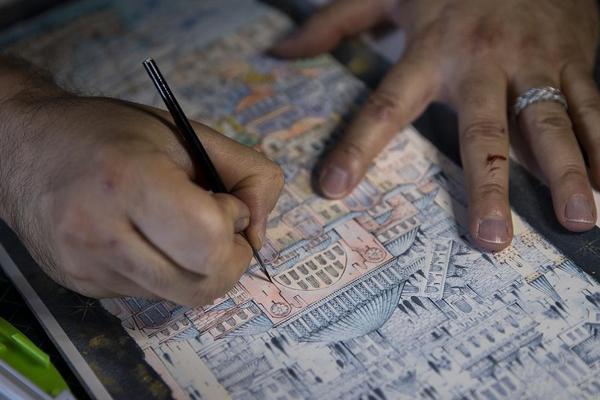Turkish miniaturist unravels intriguing world of miniature art
ISTANBUL


With art of miniature now included in the UNESCO’s Intangible Cultural Heritage List, Taner Alakuş, a Turkish miniature artist, sheds light on the way this branch of art, which has gained significant national interest, is advancing in the international arena and the potential it holds.
“Whether miniature art is a cultural heritage or not does not interest me much. Some people say that it will be known better on international platforms. This art has already become national. Now it has come to the point of being international. It could only benefit us at this point if it becomes better known,” said Alakuş, who is also working as a lecturer at Mimar Sinan Fine Arts University (MSGSU).
Speaking to the state-run Anadolu Agency, Alakuş explained what intrigued him to enter the world of miniature art, his perspective and understanding about this form of art.
Speaking about his journey of how he first got interested in traditional arts in 1982 at MSGSU, Alakuş said, “When I first started university, I had no idea about traditional arts. Though I was more interested in sculpture, painting and plastic arts, I could not pass their exams, but I somehow managed to pass the traditional Turkish arts exam.”
“My teacher, Dündar Tahsin Aykutalp, gave me a small presentation about traditional arts. It got me interest and I felt like working on this art form. I thought ‘If it is a national art belonging to us, then it would be better to learn this art.’ And then my adventure started,” he added.
Stating that there was no lecturer who taught the art of miniature at the university back then and that only one teacher gave all courses such as tile and calligraphy, Alakuş said that 40 years ago traditional arts were not that common.
“For instance, the art of marbling was not as common as it is today. A marbling artist used to come to the class, and we used to fight for his marbling. Today, they are pieces of paper that have no artistic value, but they were valuable at that time. I still have those paper marblings with me,” Alakuş said.
“Our teacher was an interesting man. It was not like a university environment, but it was an enjoyable environment. We were very attached to each other as friends. Of course, there were not that many publications and books. Right now, one can reach everything on the Internet. After which, we were able to improve our techniques ourselves,” he added.
Emphasizing that a city where one lives contributes to shaping one’s personality, Alakuş said, “Istanbul is very important. It has been the capital of three civilizations, and you can smell history everywhere. Even when I’m walking down the street, I’m always trying to create designs on my mind.”
Noting that on discovering the art and his interest in it, he understood its monetary prospects, Alakuş said: “While searching for how we can make money, we discovered bibliopoles. They were unaware of the art of miniature. We started making small artworks for these bibliopoles and that helped us to earn money. I still hear that there are people who are collecting my artworks. I produced very high-quality works at that time.”
Stating that they also made the art of illumination upon order, Alakuş said, “While we were trying to find collectors from the Grand Bazaar, there were some private collectors who found us. The prices were low, but I never complained about it. I have always stayed positive. This positivity has improved me indeed.”
“I have worked to produce private collections and calligraphy illumination for years, but I saw very good miniatures for the first time in the Süleymaniye Library. When I saw the samples there, I discovered a little more about miniature art. I made miniatures for myself and also to sell in markets,” he added.
‘Nobody makes classic miniatures better than me’
Stating that his meeting with the master artist, painter and miniaturist, Yakup Cem, was very influential on his approach to miniature art, Alakuş said that he used his experiences in terms of imparting education of miniature art to his students.
“I’ve been making miniatures for 35 years. I still feel like a college student. Since there are figures and freedom in miniature art, it attracts me even more. You can include everything in a miniature, or you can adapt a miniature to everything. I do what I want,” he added.
Alakuş stated he was also assertive about classical miniature art and has successfully mastered all its techniques.
“Nobody can make classical miniatures better than me as I have been working on it for years and have absorbed its techniques. I have miniature techniques in all my cells,” Alakuş said.
Stating that he has never been afraid of criticism, Alakuş said: “The way people look at me doesn’t really interest me. I’m just trying to empty my brain right now. I have so much work to do and have many designs on my mind, but time is not enough.”
Speaking about the addition of the miniature art in UNESCO’s Intangible Cultural Heritage List, Alakuş noted that whether the art is a cultural heritage is not his concern, but now as it has come to the point of getting recognition internationally, it could be beneficial.
“It could only benefit us at this point. I don’t have to worry about if it would contribute to us or not. My only concern is to produce my art,” he added.
Stating that he is an artist who is aware of the value of time, Alakuş said that he teaches his students by using miniature techniques in a wide range and that he offers them great freedom in this sense.
The artist has invited all those who are keen to learn miniature art to his workshop.
